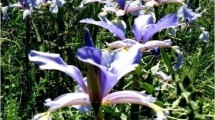Summary
The changes in the content of flavonols, anthocyanins, and carotenoids which can be observed in the anther during microsporogenesis were followed in Narcissus pseudonarcissus and in the Darwin tulip “Apeldoorn”.
The investigations revealed a distinct relationship between the process of pigmentation and the cytologic development in the anther. A marked increase in the production of flavonols occurs during and immediately after the separation of the microspores of the tetrad and seems to be connected in some specific manner with the presence of the immature pollen. In Narcissus, the total flavonol content of the anthers and their pollen and tapetum fraction reaches its highest value during the enclosure of the bud by the bulb and remains more or less unchanged until the flowers open. In contrast, an intense synthesis of flavonols does not begin in the tulip before the flower-bud has left bulb; then the flavonol content increases continuously until anthesis is reached.
The colouring of the pollen by anthocyanins does not occur until the final stages of maturation.
Without exceptions the production of carotenoids takes place after the separation of the microspores of the tetrad.
Similar content being viewed by others
Literatur
Carniel, K.: Das Antherentapetum. Öst. bot. Z. 110, 145–176 (1963).
Cooper, D. C.: The transfer of DNA from the tapetum to the microsporocyten at the onset of meiosis. Amer. Naturalist 86, 219–229 (1952).
Heslop-Harrison, J.: (a) Tapetal origin of pollen coat substances in Lilium. New Phytol. 67, 779–786 (1968).
—: (b) Anther carotinoids and the synthesis of sporopollenin. Nature (Lond.) 220, 605 (1968).
Hess, D.: Phasen der Anthocyanbildung in der Blütenentwicklung von Petunia hybrida. Planta (Berl.) 59, 567–586 (1963).
Kubitzki, K., u. H. Reznik: Flavonoid-Muster der Polycarpicae als systematisches Merkmal. I. Beitr. Biol. Pflanz. 42, 445–470 (1967).
Linskens, H. F.: Physiologische Untersuchungen zur Reifeteilung. I. Über die Änderung einiger physiologischer Zustandsgrößen während der Pollemeiose und Pollenentwicklung von Lilium henryi. Ber. dtsch. bot. Ges. 69, 353–360 (1956).
—: Physiologische Untersuchungen zur Reifeteilung. II. Über die Änderung des Nucleinsäuregehaltes während der Pollenmeiose und Pollenentwicklung von Lilium henryi. Acta bot. neerl. 7, 61–68 (1958).
Linskens, H. F.: Physiologische Untersuchungen zur Reifeteilung. V. DieÄnderung des Protein- und Enzym-Musters während der Pollenmeiose und Pollenentwicklung. Planta (Berl.) 69, 79–91 (1966).
—, u. J. A. M. Schrauwen: Änderungen des Gehaltes an Sulfhydril-Gruppen während der Pollenmeiose und Pollenentwicklung. Biol. Plantarum 5, (4), 239–248 (1963).
Miller, J. H., P. M. Miller, and H. Deal: Anthocyanin synthesis in Salpiglossis sinuata. Amer. J. Bot. 54, 1163–1170 (1967).
Pecket, R.-C.: Development of anthocyanin pigmentation in flowers of Lathyrus odoratus. J. exp. Bot. 17, 177–184 (1966).
Reznik, H.: Pigmentierungsphasen während der Blütenentwicklung von Primula obconica Hance. Flora (Jena) 150, 454–473 (1961).
Rumpenhorst, H. J.: Zur ontogenetischen Entwicklung des Flavonoidmusters von Acer pseudo-platanus, Fagopyrum esculentum und Lupinus luteus unter besonderer Berücksichtigung der Keimlingsstadien. Inaug. Diss. Münster 1968.
Schoch-Bodmer, H.: Zur Physiologie der Pollenfärbung bei Lythrum Salicaria L. Vjschr. naturforsch. Ges. Zürich 84, 225–235 (1939).
Schwanitz, G.: Untersuchungen zur postmeiotischen Mikrosporogenese. I. Morphogenese des “Ruppia”-Pollens. Pollen et Spores 9, 9–48 (1967).
Taylor, J. H.: Autoradiographic studies of nucleic acids and proteins during meiosis in Lilium longiflorum. Amer. J. Bot. 46, 477–484 (1959).
Wiermann, R.: Untersuchungen zum Phenylpropanstoffwechsel des Pollens. I. Übersicht über die bei Gymnospermen und Angiospermen isolierten flavonoiden Verbindungen. Ber. dtsch. bot. Ges. 81, 3–16 (1968).
Wiermann, R., u. H. Weinert: Untersuchungen zum Phenylpropanstoffwechsel des Pollens. III. Über die Auspigmentierung während der Endphasen der Mikrosporogenese in den Antheren der Darwintulpen-Hybride “Apeldoorn”. Z. Pflanzenphys. (im Durk) (1969).
Author information
Authors and Affiliations
Additional information
Untersuchungen zum Phenylpropanstoffwechsel des Pollens. II.
Rights and permissions
About this article
Cite this article
Wiermann, R. Über die Veränderungen des Flavonol- und Anthocyaningehaltes während der Mikrosporogenese. Planta 88, 311–320 (1969). https://doi.org/10.1007/BF00387459
Received:
Issue Date:
DOI: https://doi.org/10.1007/BF00387459




